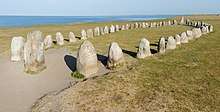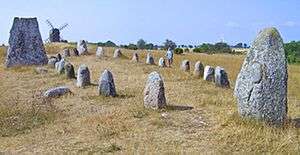Ale's Stones
Ale's Stones (Swedish: Ales stenar or Ale stenar) is a megalithic monument in Scania in southern Sweden. It is a stone ship, oval in outline, with the stones at each end markedly larger than the rest. It is 67 m (220 ft) long formed by 59 large boulders, weighing up to 1.8 tonnes each.
 Ale's Stones at Kåseberga, around ten kilometres southeast of Ystad. | |
| Location | Scania, Sweden |
|---|---|
| Coordinates | |
| Type | Monument |
| History | |
| Founded | Nordic Iron Age |
The carbon-14 dating system for organic remains has provided seven results at the site. One indicates that the material is around 5,500 years old whereas the remaining six indicate a date about 1,400 years ago. The latter is considered to be the most likely time for Ales Stenar to have been created. That would place its creation towards the end of the Nordic Iron Age.[1]
Function
The function and purpose of Ale's stones is much disputed and there are many different theories. It is generally believed to be a grave monument or a cult center, but another theory is that it is a sun calendar.[2]
A theory explained by Howard Crowhurst (ACEM, Association for the Knowledge and Study of Megaliths, in France) claims that the monument is connected with summer solstice and lunar standstill. [3]
"The Ales Stenar, known in English as the Ale's Stones, is an ancient megalithic monument of Sweden. The stones are outlining a ship. Here we show the well-known alignment of this ship along the sunset direction on summer solstice. We propose also alignments of the stones along the northern possible moonset on major and minor lunar standstills. These astronomical alignments are shown using the Photographer's Ephemeris. It is possible that this megalithic monument was used for observing the cycles of the moon." [4]
Excavations
In 1989, during the first archaeological excavations performed in order to scientifically investigate and date the monument, archaeologists found a decorated clay pot with burned human bones inside the ship setting. The bones are thought to come from a pyre and to have been placed in the pot at a later date. The pot's contents varied in age; some material was from 330–540 CE while a piece of charred food crust also found inside was determined to be from 540–650 CE.[5] The archaeologists working on the project also found birch charcoal remains from 540–650 CE underneath an undisturbed boulder.[6] According to the Swedish National Heritage Board, carbon-14 dating of the organic material from the site indicates that six of the samples are from around 600 CE, while one sample is from ca. 3500 BCE. The diverging sample came from soot-covered stones that are believed to be the remnants of an older hearth, found close to the ship setting.[6] On the basis of these results, the Swedish National Heritage Board has set a suggested date of creation for Ales Stenar to 1,400 BP,[1] which is the year 550 CE.
Gallery
 Aerial view.
Aerial view. Longitudinal view.
Longitudinal view. Information panels on site.
Information panels on site. Side view of Ales Stone.
Side view of Ales Stone. Aerial view from the ocean.
Aerial view from the ocean. View from inside the area
View from inside the area
References
- "Ales stenar". Swedish National Heritage Board. 2008-08-05. Archived from the original on 22 May 2009. Retrieved 2009-05-10.
- Ales stenar information folder, Swedish National Heritage Board
- (Amelia Carolina Sparavigna, Department of Applied Science and Technology, Politecnico di Torino)
- Strömberg, Märta (1997-05-19). "Det stora skeppet på åsen". In Jonas Ellerström and Gad Rausing (ed.). Amico amici: Gad Rausing den 19. maj 1997 (in Swedish). Signum. pp. 51–71. ISBN 91-87896-30-3.
- Kobos, Andrew M. (2001). "Ales Stenar: When? Who? What for?". Archived from the original on 2010-03-28. Retrieved 2009-05-10.
External links
| Wikimedia Commons has media related to Ales stenar. |
- The Swedish National Heritage Board's official website on Ale's Stones
- Ales stenar: 2012 Report by Swedish National Heritage Board (in Swedish)
